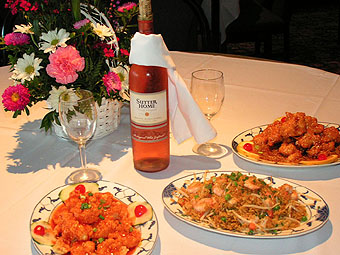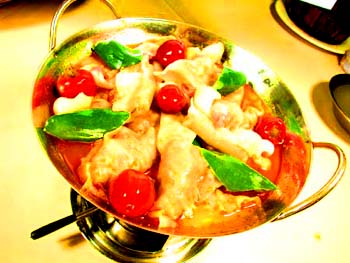|
Hunan Cuisine
by: Kirsten Hawkins
Hunan cuisine shares many commonalities with its
close, more well-known cousin, Szechwan cooking, both cuisines originate
in the Western region of China. The climate there is sub-tropical
humid and warm enough to encourage the use of fiery spices to help cool
the body, and to require high spicing of food as a preservative. With
similar climate, the two regions also share many ingredients rice is a major
staple in both diets, and chili peppers are an important part of most
dishes. The two styles of regional cuisine are similar enough that many
restaurants and cookbooks lump them together under Western Chinese
cooking or simple refer to both as Szechwan cuisine.
climate, the two regions also share many ingredients rice is a major
staple in both diets, and chili peppers are an important part of most
dishes. The two styles of regional cuisine are similar enough that many
restaurants and cookbooks lump them together under Western Chinese
cooking or simple refer to both as Szechwan cuisine.
There are some important differences, though.
Hunan cooking is, for one thing, even more fiery than most Szechwan
dishes. Szechwan dishes often include chili paste for rubbing into
meats, or including in sauce. Hunan chefs include the entire dried chili
pepper, with its intensely spicy seeds and rind.
The differences in the actual land of the two
regions also has an effect on the differences in their cuisine. The
Szechwan region is mountainous jungle, with little arable land for
farming. The Hunan region, by contrast, is a land of soft rolling hills
and slow rivers. Because of its fertile hillocks and valleys, the Hunan
region has access to an amazing variety of ingredients that arent
available to Szechwan chefs. Seafood and beef are both far more common
in Hunan cooking, as are many vegetables.
The land, and the hardships associated with it,
also give the Hunan more time to concentrate on food. Hunan cooking
features complex and time-consuming preparation time. Many dishes begin
their preparation the day before they are to be served, and may be
marinated, then steamed or smoked, and finally deep-fried or stewed
before they reach the table. The same attention is paid to the
preparation of ingredients, and it is said that Hunan cuisine is the
most pleasing to the eye of all Chinese cuisines. The shape of a food in
a particular recipe is nearly as important as its presence in the final
dish. Hunan chefs are specialists with the knife carving fanciful
shapes of vegetables and fruits that will be used in preparing meals, or
to present them.
 Hunan cuisine is noted for its use of chili
peppers, garlic and shallots, and for the use of sauces to accent the
flavors in the ingredients of a dish. It is not uncommon for a Hunan
dish to play on the contrasts of flavors hot and sour, sweet and sour,
sweet and hot pungent, spicy and deliciously sweet all at once. Hunan
chefs are noted for their ability to create a symphony of taste with
their ingredients. A classic example is Hunan spicy beef with
vegetables, where the beef is first marinated overnight in a citrus and
ginger mixture, then washed and rubbed with chili paste before being
simmered in a pungent brown sauce. The end result is a meat that is
meltingly tender on the tongue and changes flavor even as you enjoy it. Hunan cuisine is noted for its use of chili
peppers, garlic and shallots, and for the use of sauces to accent the
flavors in the ingredients of a dish. It is not uncommon for a Hunan
dish to play on the contrasts of flavors hot and sour, sweet and sour,
sweet and hot pungent, spicy and deliciously sweet all at once. Hunan
chefs are noted for their ability to create a symphony of taste with
their ingredients. A classic example is Hunan spicy beef with
vegetables, where the beef is first marinated overnight in a citrus and
ginger mixture, then washed and rubbed with chili paste before being
simmered in a pungent brown sauce. The end result is a meat that is
meltingly tender on the tongue and changes flavor even as you enjoy it.
More and more, restaurants are beginning to sort
out the two cuisines, and Hunan cuisine is coming into its own. Crispy
duck and Garlic-Fried String Beans are taking their place alongside Kung
Pao Chicken and Double Cooked Spicy Pork. But there is no battle between
the two for a place of honor among Chinese Regional cuisines rather,
there are only winners the diners who have the pleasure of sampling
both. |


 climate, the two regions also share many ingredients rice is a major
staple in both diets, and chili peppers are an important part of most
dishes. The two styles of regional cuisine are similar enough that many
restaurants and cookbooks lump them together under Western Chinese
cooking or simple refer to both as Szechwan cuisine.
climate, the two regions also share many ingredients rice is a major
staple in both diets, and chili peppers are an important part of most
dishes. The two styles of regional cuisine are similar enough that many
restaurants and cookbooks lump them together under Western Chinese
cooking or simple refer to both as Szechwan cuisine.  Hunan cuisine is noted for its use of chili
peppers, garlic and shallots, and for the use of sauces to accent the
flavors in the ingredients of a dish. It is not uncommon for a Hunan
dish to play on the contrasts of flavors hot and sour, sweet and sour,
sweet and hot pungent, spicy and deliciously sweet all at once. Hunan
chefs are noted for their ability to create a symphony of taste with
their ingredients. A classic example is Hunan spicy beef with
vegetables, where the beef is first marinated overnight in a citrus and
ginger mixture, then washed and rubbed with chili paste before being
simmered in a pungent brown sauce. The end result is a meat that is
meltingly tender on the tongue and changes flavor even as you enjoy it.
Hunan cuisine is noted for its use of chili
peppers, garlic and shallots, and for the use of sauces to accent the
flavors in the ingredients of a dish. It is not uncommon for a Hunan
dish to play on the contrasts of flavors hot and sour, sweet and sour,
sweet and hot pungent, spicy and deliciously sweet all at once. Hunan
chefs are noted for their ability to create a symphony of taste with
their ingredients. A classic example is Hunan spicy beef with
vegetables, where the beef is first marinated overnight in a citrus and
ginger mixture, then washed and rubbed with chili paste before being
simmered in a pungent brown sauce. The end result is a meat that is
meltingly tender on the tongue and changes flavor even as you enjoy it.